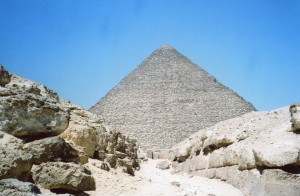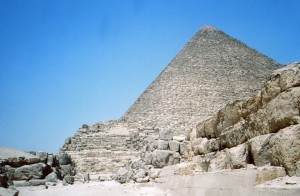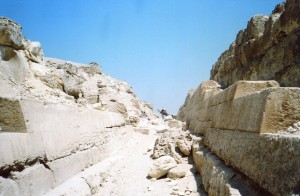The Great Pyramid at Giza is more than a pyramid. King Khufu added many other buildings to his burial site that added more meanings to Giza.
You can appreciate Giza much more by exploring the buildings around the Great Pyramid.
1. A stone causeway almost half a mile long led from the Nile to the pyramid’s east side. The 5th century BCE Greek historian, Herodotus said that its walls were carved with reliefs.
2. The causeway ended at a large stone mortuary temple with an open courtyard and storage rooms. This was the first large stone temple in Egypt.
3. A 26 foot high limestone wall surrounded the rest of the Great Pyramid–access to the pyramid was only through the temple.
4. Three queens’ pyramids were built along the east side. You can see one in the above photo.
5. Two boat pits flanked the mortuary temple. One pit was excavated and the remains of a 142 foot-long boat were found and reassembled. Scholars don’t agree whether it was buried for symbolic value (to transport Khufu across the sky with the sun or stars), or whether it was used to just transport his body to the pyramid.
6. Several rows of tombs in the form of mastabas (single-level rectangular blocks) line the Great Pyramid’s east and west sides. They were probably used for high-ranking officials and other members of the royal family. As the above picture shows, they were built in neat rows, like streets of a modern city.
So Khufu imagined Giza, not just as the Great Pyramid, but an entire society that included his family and high-level administrators. The order that unified the civilized world was thus given eternal life.
If you have a chance to go there, linger around these buildings for a while, and you can appreciate them as an integrated community.




Comments on this entry are closed.